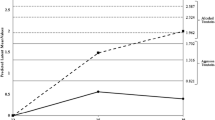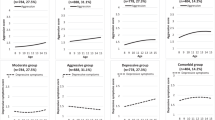Abstract
This study sought to identify trajectories of physical aggression among urban Hispanic youth, and to examine the effects of risk and protective factors at age 11 on trajectories of physical aggression over time (ages 12–18). Relying on data from 731 urban Hispanic adolescents from Project Northland Chicago (PNC), latent trajectory modeling was used to determine the number of trajectories, and multinomial logistic regression was used to identify the predictors associated with trajectory membership. The results suggested five trajectories of physical aggression (non-aggressive, low stable, escalators, early-rapid desistors, and high aggression/moderate desistors). After adjusting for several risk and protective factors, language preference (e.g. speaking Spanish at home) was identified as a protective factor, while indirect exposure to alcohol, sadness/depression, fewer negative alcohol-related attitudes, and threatening to fight were associated with increased risk for physical aggression. Study implications indicate that early, multilevel prevention efforts are necessary to deter the initiation and promote the desistance of physical aggression over time among urban Hispanic adolescents.

Similar content being viewed by others
References
Agnew, R. (2001). Building on the foundation of general strain theory: specifying the types of strain most likely to lead to crime and delinquency. Journal of Research in Crime and Delinquency, 38, 319–361.
Agnew, R. (2006). Pressured into crime: An overview of general strain theory. Los Angeles: Roxbury.
Akers, R. L. (1985). Deviant behavior: A social learning approach (3rd ed.). Belmont, CA: Wadsworth.
Akers, T. A., & Lanier, M. M. (2009). Epidemiological crimonology: coming full circle. Health Policy and Ethics, 99, 397–402.
Center for Disease Control and Prevention. (2009). Web-based injury statistics query and reporting system (WISQARS). Retrieved November 5, 2009 http://www.cdc.gov/injury/wisqars/index.html.
Coulton, C. J., Korbin, J. E., Su, M., & Chow, J. (1995). Community level factors and child maltreatment rates. Child Development, 66, 1262–1276.
Duncan, S. C., Duncan, T. E., & Strycker, L. A. (2002). A multilevel analysis of neighborhood context and youth alcohol and drug problems. Prevention Science, 3, 125–133.
Elliott, D., Wilson, W. J., Huizinga, D., Sampson, R. J., Elliott, A., & Rankin, B. (1996). The effects of neighborhood disadvantage on adolescent development. Journal of Research in Crime and Delinquency, 34, 389–426.
Fontaine, N., Carbonneau, R., Vitaro, F., Barker, E. D., & Tremblay, R. E. (2009). Research review: a critical review of studies on the developmental trajectories of antisocial behavior in females. Journal of Child Psychology & Psychiatry, 50, 363–385.
Hawkins, J. D., Catalano, R. F., & Miller, J. Y. (1992). Risk and protective factors for alcohol and other drug problems in adolescence and early adulthood: implications for substance-abuse prevention. Psychological Bulletin, 112, 64–105.
Haynie, D. L., & Osgood, D. W. (2005). Reconsidering peers and delinquency: how do peers matter? Social Forces, 84, 1109–1130.
Jennings, W. G., Piquero, N. L., Gover, A. R., & Pérez, D. (2009). Gender and general strain theory: a replication and exploration of Broidy and Agnew’s gender/strain hypothesis among a sample of southwestern Mexican American adolescents. Journal of Criminal Justice, 37, 404–417.
Jennings, W. G., Maldonado-Molina, M. M., Piquero, A., & Canino, G. (2010). Parental suicidality as a risk factor for delinquency among Hispanic youth. Journal of Youth and Adolescence, 39, 315–325.
Jessor, R. (1991). Risk behavior in adolescence: a psychosocial framework for understanding and action. Journal of Adolescent Health, 12, 597–605.
Jessor, R., Van Den Boss, J., Vanderryn, J., Costa, F. M., & Turbin, M. S. (1995). Protective factors in adolescent problem behavior: moderator effects and developmental change. Developmental Psychology, 31, 923–933.
Jones, B. L., Nagin, D. S., & Roeder, K. (2001). A SAS procedure based on mixture models for estimating developmental trajectories. Sociological Methods & Research, 29, 374–393.
Komro, K. A., Perry, C. L., Veblen-Mortenson, S., Bosma, L. M., Dudovitz, B. S., Williams, C. L., et al. (2004). Brief report: the adaptation of Project Northland for urban youth. Journal of Pediatric Psychology, 29, 457–466.
Komro, K. A., Perry, C. L., Veblen-Mortenson, S., Farbakhsh, K., Toomey, T. L., Stigler, M. H., et al. (2008). Outcomes from a randomized controlled trial of a multi-component alcohol use preventive intervention for urban youth: Project Northland Chicago. Addiction, 103, 606–618.
Loeber, R., Burke, J. D., & Pardini, D. A. (2009). Development and etiology of disruptive and delinquent behavior. Annual Review of Clinical Psychology, 5, 291–310.
Loukas, A., Prelow, H. M., & Suizzo, M. (2008). Mothering and peer associations mediate cumulative risk effects for Latino youth. Journal of Marriage and the Family, 70, 76–85.
Maldonado-Molina, M. M., Piquero, A. R., Jennings, W. G., Bird, H., & Canino, G. (2009). Trajectories of delinquency among Puerto Rican children and adolescents at two sites. Journal of Research on Crime and Delinquency, 46, 144–181.
Maldonado-Molina, M. M., Jennings, W. G., & Komro, K. A. (in press). Effects of alcohol on trajectories of physical aggression among urban youth: an application of latent trajectory modeling. Journal of Youth and Adolescence. doi:10.1007/s10964-009-9484-y
McCord, J., Widom, C. S., & Crowell, N. A. (Eds.). (2001). Juvenile crime, juvenile justice. Panel on juvenile crime: Prevention, treatment, and control. Washington, DC: National Academy Press.
Moffitt, T. E. (2006). Life-course persistent versus adolescent-limited antisocial behavior. In D. Cicchetti & D. Cohen (Eds.), Developmental psychopathology (2nd ed., pp. 570–598). New York: Wiley.
Nagin, D. S. (2005). Group-based modeling of development. Cambridge, MA: Harvard University Press.
Osgood, D. W., & Anderson, A. (2004). Unstructured socializing and rates of delinquency. Criminology, 42, 519–549.
Osgood, D. W., Wilson, J. K., Bachman, J. G., O’Malley, P. M., & Johnson, L. D. (1996). Routine activities and individual deviant behavior. American Sociological Review, 61, 635–655.
Pantin, H., Prado, G., Lopez, B., Huang, S., Tapia, M., Schwartz, S., et al. (2009). A randomized trial of Familias Unidas for Hispanic adolescents with behavior problems. Psychosomatic Medicine, 71, 987–995.
Pérez, D. M., Jennings, W. G., & Gover, A. R. (2008). Specifying general strain theory: an ethnically relevant approach. Deviant Behavior, 29, 544–578.
Pew Hispanic Center. (2010). Statistical portrait of Hispanics in the United States, 2008. Retrieved February 4, 2010, from http://pewhispanic.org/factsheets/factsheet.php?FactsheetID=58.
Piquero, A. R. (2008). Taking stock of developmental trajectories of criminal activity over the life course. In A. Liberman (Ed.), The long view of crime: A synthesis of longitudinal research. New York: Springer.
Piquero, A. R., Daigle, L. E., Gibson, C., Piquero, N. L., & Tibbetts, S. G. (2007). Are life-course-persistent offenders at risk for adverse health outcomes? Journal of Research in Crime & Delinquency, 44, 185–207.
Prado, G., Pantin, H., Briones, E., Schwartz, S. J., Feaster, D., Huang, S., et al. (2007). A randomized controlled trial of a parent-centered intervention in preventing substance use and HIV risk behaviors in Hispanic adolescents. Journal of Consulting and Clinical Psychology, 75, 914–926.
Schwartz, G. (1978). Estimating dimensions of a model. Annals of Statistics, 6, 461–464.
Schwartz, S. J., Unger, J. B., Zamboanga, B. L., & Szapocznik, J. (in press). Rethinking the concept of acculturation: implications for theory and research. American Psychologist.
StataCorp. (2009). Stata statistical software: Release 11. College Station, TX: StataCorp LP.
U.S. Census Bureau. (2005). Hispanic population passes 40 million, Census Bureau Reports. Washington, D.C.: United States Census Bureau.
Acknowledgments
This study was funded by grants from the National Institute on Alcohol Abuse and Alcoholism and the National Institute on Minority Health and Health Disparities (AA017480, AA013458 and AA016549). The authors thank Karen Alfano, MBA and Carolyn Kulb, B.A., for survey design and management of data collection, Kian Farbakhsh, M.S., for database design and management, and Cheryl Perry, PhD, for her overall contributions to the PNC study. We gratefully acknowledge the participation of students and parents.
Author information
Authors and Affiliations
Corresponding author
Rights and permissions
About this article
Cite this article
Maldonado-Molina, M.M., Reingle, J.M., Tobler, A.L. et al. Trajectories of Physical Aggression Among Hispanic Urban Adolescents and Young Adults: An Application of Latent Trajectory Modeling from Ages 12 to 18. Am J Crim Just 35, 121–133 (2010). https://doi.org/10.1007/s12103-010-9074-2
Published:
Issue Date:
DOI: https://doi.org/10.1007/s12103-010-9074-2




